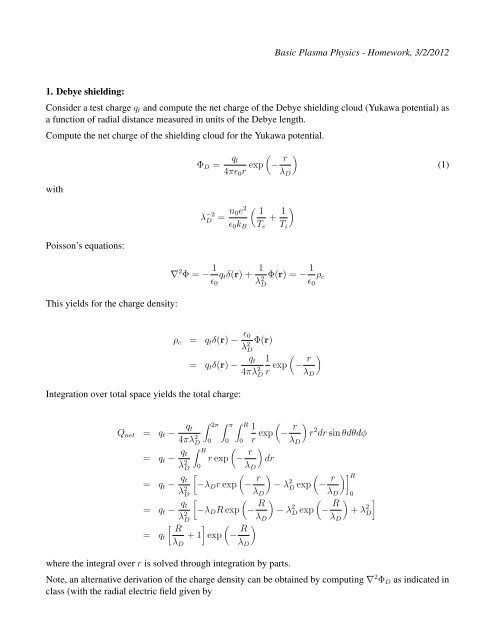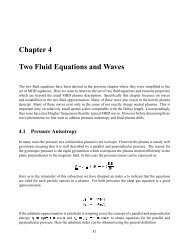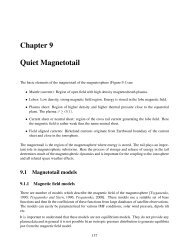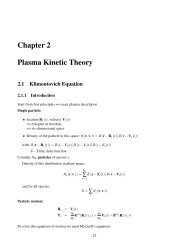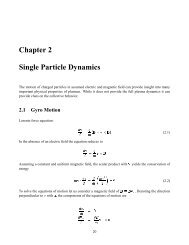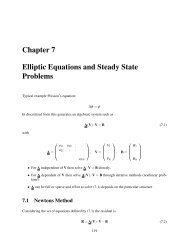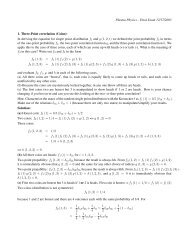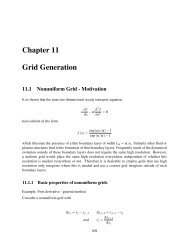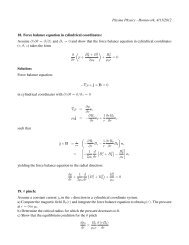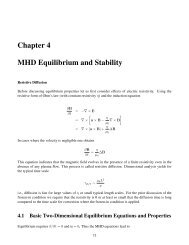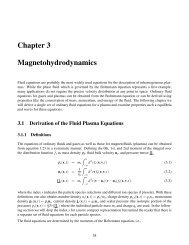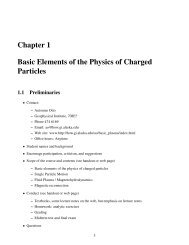Basic Plasma Physics - Homework, 3/2/2012 1. Debye shielding ...
Basic Plasma Physics - Homework, 3/2/2012 1. Debye shielding ...
Basic Plasma Physics - Homework, 3/2/2012 1. Debye shielding ...
Create successful ePaper yourself
Turn your PDF publications into a flip-book with our unique Google optimized e-Paper software.
<strong>Basic</strong> <strong>Plasma</strong> <strong>Physics</strong> - <strong>Homework</strong>, 3/2/<strong>2012</strong><br />
<strong>1.</strong> <strong>Debye</strong> <strong>shielding</strong>:<br />
Consider a test charge q t and compute the net charge of the <strong>Debye</strong> <strong>shielding</strong> cloud (Yukawa potential) as<br />
a function of radial distance measured in units of the <strong>Debye</strong> length.<br />
Compute the net charge of the <strong>shielding</strong> cloud for the Yukawa potential.<br />
with<br />
Poisson’s equations:<br />
Φ D =<br />
q (<br />
t<br />
4πɛ 0 r exp − r )<br />
λ D<br />
λ −2<br />
D = n 0e 2<br />
ɛ 0 k B<br />
( 1<br />
T e<br />
+ 1 T i<br />
)<br />
∇ 2 Φ = − 1 q t δ(r) + 1 Φ(r) = − 1 ρ<br />
ɛ 0 λ 2 c<br />
D ɛ 0<br />
(1)<br />
This yields for the charge density:<br />
ρ c = q t δ(r) − ɛ 0<br />
Φ(r)<br />
λ 2 D<br />
= q t δ(r) − q t<br />
4πλ 2 D<br />
Integration over total space yields the total charge:<br />
(<br />
1<br />
r exp − r )<br />
λ D<br />
Q net = q t − q t<br />
4πλ 2 D<br />
= q t − q t<br />
λ 2 D<br />
= q t − q t<br />
λ 2 D<br />
= q t − q t<br />
λ 2 D<br />
∫ 2π ∫ π ∫ R<br />
0<br />
∫ R<br />
0<br />
[ ] R<br />
= q t + 1<br />
λ D<br />
0<br />
r exp<br />
[<br />
−λ D r exp<br />
[<br />
−λ D R exp<br />
0<br />
(<br />
− r<br />
(<br />
1<br />
r exp − r )<br />
r 2 dr sin θdθdφ<br />
λ D<br />
)<br />
dr<br />
λ D<br />
(<br />
− r<br />
exp<br />
(− R )<br />
λ D<br />
)<br />
(<br />
− λ 2 D exp − r )] R<br />
λ D λ D 0<br />
(− R )<br />
− λ 2 D exp<br />
(− R ) ]<br />
+ λ 2 D<br />
λ D λ D<br />
where the integral over r is solved through integration by parts.<br />
Note, an alternative derivation of the charge density can be obtained by computing ∇ 2 Φ D as indicated in<br />
class (with the radial electric field given by
E r = − ∂Φ ( )<br />
(<br />
r<br />
∂r = q t<br />
+ 1<br />
λ D 4πɛ 0 r exp − r )<br />
2 λ D<br />
Q net =<br />
∫ R<br />
sphere<br />
ρ c d 3 r = ɛ 0<br />
∫ R<br />
sphere<br />
∇ · Ed 3 r<br />
∫ R<br />
= ɛ 0 E · d 2 s = 4πR 2 ɛ 0 E r (R)<br />
surface<br />
( ) R<br />
= q t + 1 exp<br />
(− R )<br />
λ D λ D<br />
Note be care full to consider that ∇(1/r) = r/r 3 and ∇ · (r/r 3 ) = 4πδ(r).<br />
2. <strong>Plasma</strong> properties:<br />
(a) Calculate the electron thermal speed, <strong>Debye</strong> length, and the plasma parameter for<br />
• a tokamak plasma with T e = 10 8 K, n 0 =10 19 m −3<br />
• the tail magnetosphere with T e = 10 7 K, n 0 =10 6 m −3<br />
• the ionosphere with T e = 10 3 K, n 0 =10 12 m −3<br />
• the solar atmosphere with T e = 10 4 K, n 0 =10 20 m −3<br />
with k B = <strong>1.</strong>38 · 10 −23 JK −1 , ɛ 0 = 8.85 · 10 −12 F/m, m e = 9.11 · 10 −31 kg, and e = <strong>1.</strong>60 · 10 −19 C<br />
Solution: Electron thermal speed:<br />
Electron <strong>Debye</strong> length:<br />
( ) 1/2<br />
kB T e<br />
v the =<br />
= 3.9 · 10 3 Te<br />
1/2 m/s<br />
m e<br />
λ De =<br />
=<br />
( ) 1/2<br />
ɛ0 k B T e<br />
n 0 e 2<br />
( 8.85 · 10<br />
−12 · <strong>1.</strong>38 · 10 −23 ) 1/2 (Te<br />
<strong>1.</strong>6 2 · 10 −38<br />
n 0<br />
) 1/2<br />
m<br />
= 69.1 ·<br />
( Te<br />
n 0<br />
) 1/2<br />
m<br />
Electron plasma parameter:<br />
Λ e = n 0 λ 3 De = 3.3 · 10 5 T 3/2<br />
e<br />
n 1/2<br />
0
T e / K n 0 / m −3 v the / m/s λ De / m Λ e<br />
Tokamak 10 8 10 19 3.9 · 10 7 2.2 · 10 −4 <strong>1.</strong>04 · 10 8<br />
Magnetotail 10 7 10 6 <strong>1.</strong>2 · 10 7 220 <strong>1.</strong>04 · 10 13<br />
Ionosphere 10 3 10 12 <strong>1.</strong>2 · 10 5 2.2 · 10 −3 <strong>1.</strong>04 · 10 4<br />
Solar atmosphere 10 4 10 20 3.9 · 10 5 6.9 · 10 −7 33<br />
(b) Compute collision frequency and mean free path for these plasmas.<br />
Solution: <strong>Plasma</strong> frequency:<br />
ω pe =<br />
(<br />
n0 e 2<br />
m e ɛ 0<br />
) 1/2<br />
(2)<br />
ω pe =<br />
Collision frequency:<br />
(<br />
n0 e 2<br />
m e ɛ 0<br />
) 1/2<br />
= <strong>1.</strong>60 · 10 −19 (<br />
n 0<br />
) 1/2<br />
<strong>1.</strong>60 · 10 −19<br />
=<br />
9.11 · 10 −31 8.85 · 10 −12 2.84 · 10<br />
−21<br />
n1/2<br />
0 = 56.34n 1/2<br />
0<br />
Mean free path:<br />
√ π 1 ω p<br />
ν c =<br />
ln [12πΛ]<br />
2 32π Λ<br />
= <strong>1.</strong>247 · 10 −2 ω p<br />
ln (37.7Λ)<br />
Λ<br />
L c = v the /ν c<br />
=<br />
√ ( ) 1/2 (me )<br />
√<br />
2<br />
π 32π kB T e ɛ 1/2 0 Λ 2<br />
m e n 0 e 2 ln [12πΛ] = π 32π λ DeΛ<br />
ln [12πΛ]<br />
n 0 / m −3 Λ e v the / m/s ω p / s −1 ν c / s −1 ln (37.7Λ) L c / m<br />
Tokamak 10 19 <strong>1.</strong>04 · 10 8 3.9 · 10 7 <strong>1.</strong>78 · 10 11 4.71 · 10 2 22.09 8.28 · 10 4<br />
Magnetotail 10 6 <strong>1.</strong>04 · 10 13 <strong>1.</strong>2 · 10 7 5.63 · 10 4 2.27 · 10 −9 33.60 5.29 · 10 15<br />
Ionosphere 10 12 <strong>1.</strong>04 · 10 4 <strong>1.</strong>2 · 10 5 5.63 · 10 7 8.69 · 10 2 12.88 <strong>1.</strong>38 · 10 2<br />
Solar Atmosph. 10 20 33 3.9 · 10 5 5.63 · 10 11 <strong>1.</strong>52 · 10 9 7.13 2.5 · 10 −4
3. <strong>Plasma</strong> Definition<br />
Can a fully ionized plasma be maintained at temperatures of T e = 100 K (Hint: derive a condition for the<br />
density in relation to the temperature). How important is recombination for such a cold plasma<br />
Solution:<br />
<strong>Plasma</strong> definition:<br />
Taking the square<br />
Λ = nλ 3 D = n −1/2 (<br />
ɛ0 k B T e<br />
e 2 ) 3/2<br />
≫ 1<br />
n −1 (<br />
ɛ0 k B T e<br />
e 2 ) 3<br />
= n −1 ( 8.85 · 10<br />
−12 · <strong>1.</strong>38 · 10 −23 · 10 2<br />
<strong>1.</strong>6 2 · 10 −38 ) 3 [<br />
m<br />
−3 ]<br />
= n −1 ( 4.8 · 10 5) 3 [ m −3] = n −1 · <strong>1.</strong>1 · 10 17 [ m −3]<br />
or taking number density as particle per cm −3 √ n ≪ 3.3 · 10<br />
5<br />
which implies that n could be as small as 10 7 or even 10 8 cm −3 to satisfy the plasma definition, i.e., that<br />
the potential energy is much smaller than the kinetic energy of the charged particles.<br />
While this is true there is the additional aspect of how long such a plasma could be maintained. Even<br />
tho a sufficiently low density gas of charged particles can satisfy the plasma definition, recombination<br />
caused by collisions can remove the the charged particles. For long life time of such a plasma it would<br />
be necessary to have a very low level of collisions that could result in recombinations. In other words<br />
the collision frequency must be sufficiently low and with a comparatively small value of the plasma<br />
parameter of for instance 10 2 the collision frequency is still quite large and would lead to relatively fast<br />
recombination leading to a loss of this plasma within a short time frame.


